Yue Zhang
Renmin University of China
PaddleOCR-VL: Boosting Multilingual Document Parsing via a 0.9B Ultra-Compact Vision-Language Model
Oct 16, 2025Abstract:In this report, we propose PaddleOCR-VL, a SOTA and resource-efficient model tailored for document parsing. Its core component is PaddleOCR-VL-0.9B, a compact yet powerful vision-language model (VLM) that integrates a NaViT-style dynamic resolution visual encoder with the ERNIE-4.5-0.3B language model to enable accurate element recognition. This innovative model efficiently supports 109 languages and excels in recognizing complex elements (e.g., text, tables, formulas, and charts), while maintaining minimal resource consumption. Through comprehensive evaluations on widely used public benchmarks and in-house benchmarks, PaddleOCR-VL achieves SOTA performance in both page-level document parsing and element-level recognition. It significantly outperforms existing solutions, exhibits strong competitiveness against top-tier VLMs, and delivers fast inference speeds. These strengths make it highly suitable for practical deployment in real-world scenarios.
LOGicalThought: Logic-Based Ontological Grounding of LLMs for High-Assurance Reasoning
Oct 02, 2025Abstract:High-assurance reasoning, particularly in critical domains such as law and medicine, requires conclusions that are accurate, verifiable, and explicitly grounded in evidence. This reasoning relies on premises codified from rules, statutes, and contracts, inherently involving defeasible or non-monotonic logic due to numerous exceptions, where the introduction of a single fact can invalidate general rules, posing significant challenges. While large language models (LLMs) excel at processing natural language, their capabilities in standard inference tasks do not translate to the rigorous reasoning required over high-assurance text guidelines. Core reasoning challenges within such texts often manifest specific logical structures involving negation, implication, and, most critically, defeasible rules and exceptions. In this paper, we propose a novel neurosymbolically-grounded architecture called LOGicalThought (LogT) that uses an advanced logical language and reasoner in conjunction with an LLM to construct a dual symbolic graph context and logic-based context. These two context representations transform the problem from inference over long-form guidelines into a compact grounded evaluation. Evaluated on four multi-domain benchmarks against four baselines, LogT improves overall performance by 11.84% across all LLMs. Performance improves significantly across all three modes of reasoning: by up to +10.2% on negation, +13.2% on implication, and +5.5% on defeasible reasoning compared to the strongest baseline.
DeepScientist: Advancing Frontier-Pushing Scientific Findings Progressively
Sep 30, 2025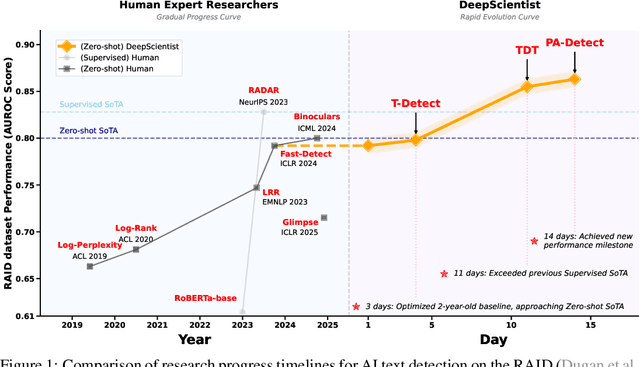

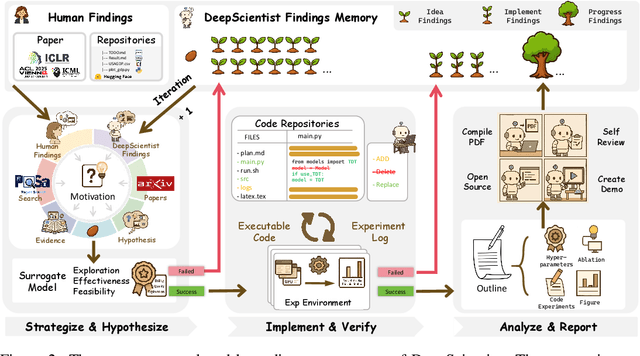

Abstract:While previous AI Scientist systems can generate novel findings, they often lack the focus to produce scientifically valuable contributions that address pressing human-defined challenges. We introduce DeepScientist, a system designed to overcome this by conducting goal-oriented, fully autonomous scientific discovery over month-long timelines. It formalizes discovery as a Bayesian Optimization problem, operationalized through a hierarchical evaluation process consisting of "hypothesize, verify, and analyze". Leveraging a cumulative Findings Memory, this loop intelligently balances the exploration of novel hypotheses with exploitation, selectively promoting the most promising findings to higher-fidelity levels of validation. Consuming over 20,000 GPU hours, the system generated about 5,000 unique scientific ideas and experimentally validated approximately 1100 of them, ultimately surpassing human-designed state-of-the-art (SOTA) methods on three frontier AI tasks by 183.7\%, 1.9\%, and 7.9\%. This work provides the first large-scale evidence of an AI achieving discoveries that progressively surpass human SOTA on scientific tasks, producing valuable findings that genuinely push the frontier of scientific discovery. To facilitate further research into this process, we will open-source all experimental logs and system code at https://github.com/ResearAI/DeepScientist/.
Uncertainty-Gated Deformable Network for Breast Tumor Segmentation in MR Images
Sep 19, 2025



Abstract:Accurate segmentation of breast tumors in magnetic resonance images (MRI) is essential for breast cancer diagnosis, yet existing methods face challenges in capturing irregular tumor shapes and effectively integrating local and global features. To address these limitations, we propose an uncertainty-gated deformable network to leverage the complementary information from CNN and Transformers. Specifically, we incorporates deformable feature modeling into both convolution and attention modules, enabling adaptive receptive fields for irregular tumor contours. We also design an Uncertainty-Gated Enhancing Module (U-GEM) to selectively exchange complementary features between CNN and Transformer based on pixel-wise uncertainty, enhancing both local and global representations. Additionally, a Boundary-sensitive Deep Supervision Loss is introduced to further improve tumor boundary delineation. Comprehensive experiments on two clinical breast MRI datasets demonstrate that our method achieves superior segmentation performance compared with state-of-the-art methods, highlighting its clinical potential for accurate breast tumor delineation.
ALLabel: Three-stage Active Learning for LLM-based Entity Recognition using Demonstration Retrieval
Sep 09, 2025Abstract:Many contemporary data-driven research efforts in the natural sciences, such as chemistry and materials science, require large-scale, high-performance entity recognition from scientific datasets. Large language models (LLMs) have increasingly been adopted to solve the entity recognition task, with the same trend being observed on all-spectrum NLP tasks. The prevailing entity recognition LLMs rely on fine-tuned technology, yet the fine-tuning process often incurs significant cost. To achieve a best performance-cost trade-off, we propose ALLabel, a three-stage framework designed to select the most informative and representative samples in preparing the demonstrations for LLM modeling. The annotated examples are used to construct a ground-truth retrieval corpus for LLM in-context learning. By sequentially employing three distinct active learning strategies, ALLabel consistently outperforms all baselines under the same annotation budget across three specialized domain datasets. Experimental results also demonstrate that selectively annotating only 5\%-10\% of the dataset with ALLabel can achieve performance comparable to the method annotating the entire dataset. Further analyses and ablation studies verify the effectiveness and generalizability of our proposal.
Breaking Down and Building Up: Mixture of Skill-Based Vision-and-Language Navigation Agents
Aug 11, 2025Abstract:Vision-and-Language Navigation (VLN) poses significant challenges in enabling agents to interpret natural language instructions and navigate complex 3D environments. While recent progress has been driven by large-scale pre-training and data augmentation, current methods still struggle to generalize to unseen scenarios, particularly when complex spatial and temporal reasoning is required. In this work, we propose SkillNav, a modular framework that introduces structured, skill-based reasoning into Transformer-based VLN agents. Our method decomposes navigation into a set of interpretable atomic skills (e.g., Vertical Movement, Area and Region Identification, Stop and Pause), each handled by a specialized agent. We then introduce a novel zero-shot Vision-Language Model (VLM)-based router, which dynamically selects the most suitable agent at each time step by aligning sub-goals with visual observations and historical actions. SkillNav achieves a new state-of-the-art performance on the R2R benchmark and demonstrates strong generalization to the GSA-R2R benchmark that includes novel instruction styles and unseen environments.
LLMEval-3: A Large-Scale Longitudinal Study on Robust and Fair Evaluation of Large Language Models
Aug 07, 2025Abstract:Existing evaluation of Large Language Models (LLMs) on static benchmarks is vulnerable to data contamination and leaderboard overfitting, critical issues that obscure true model capabilities. To address this, we introduce LLMEval-3, a framework for dynamic evaluation of LLMs. LLMEval-3 is built on a proprietary bank of 220k graduate-level questions, from which it dynamically samples unseen test sets for each evaluation run. Its automated pipeline ensures integrity via contamination-resistant data curation, a novel anti-cheating architecture, and a calibrated LLM-as-a-judge process achieving 90% agreement with human experts, complemented by a relative ranking system for fair comparison. An 20-month longitudinal study of nearly 50 leading models reveals a performance ceiling on knowledge memorization and exposes data contamination vulnerabilities undetectable by static benchmarks. The framework demonstrates exceptional robustness in ranking stability and consistency, providing strong empirical validation for the dynamic evaluation paradigm. LLMEval-3 offers a robust and credible methodology for assessing the true capabilities of LLMs beyond leaderboard scores, promoting the development of more trustworthy evaluation standards.
Seed-Prover: Deep and Broad Reasoning for Automated Theorem Proving
Aug 01, 2025Abstract:LLMs have demonstrated strong mathematical reasoning abilities by leveraging reinforcement learning with long chain-of-thought, yet they continue to struggle with theorem proving due to the lack of clear supervision signals when solely using natural language. Dedicated domain-specific languages like Lean provide clear supervision via formal verification of proofs, enabling effective training through reinforcement learning. In this work, we propose \textbf{Seed-Prover}, a lemma-style whole-proof reasoning model. Seed-Prover can iteratively refine its proof based on Lean feedback, proved lemmas, and self-summarization. To solve IMO-level contest problems, we design three test-time inference strategies that enable both deep and broad reasoning. Seed-Prover proves $78.1\%$ of formalized past IMO problems, saturates MiniF2F, and achieves over 50\% on PutnamBench, outperforming the previous state-of-the-art by a large margin. To address the lack of geometry support in Lean, we introduce a geometry reasoning engine \textbf{Seed-Geometry}, which outperforms previous formal geometry engines. We use these two systems to participate in IMO 2025 and fully prove 5 out of 6 problems. This work represents a significant advancement in automated mathematical reasoning, demonstrating the effectiveness of formal verification with long chain-of-thought reasoning.
T-Detect: Tail-Aware Statistical Normalization for Robust Detection of Adversarial Machine-Generated Text
Jul 31, 2025
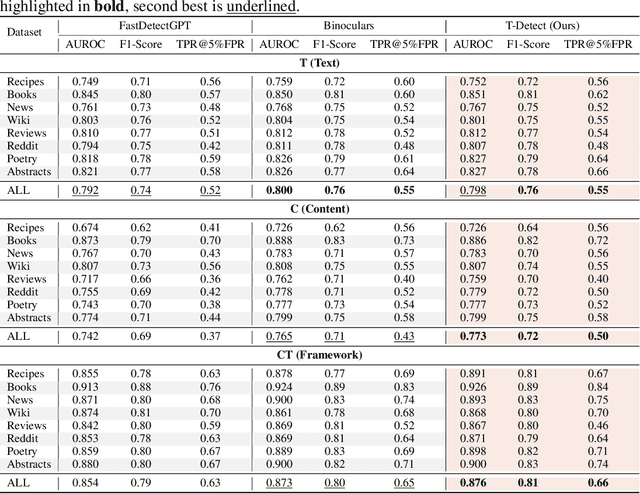
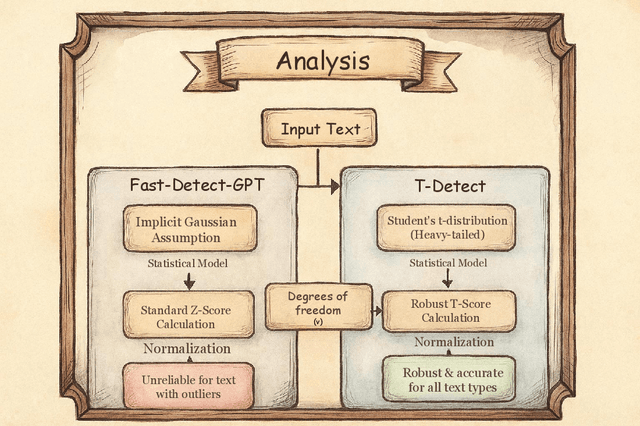
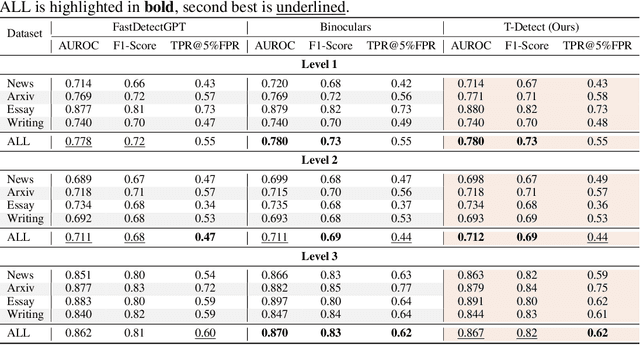
Abstract:The proliferation of sophisticated text generation models necessitates the development of robust detection methods capable of identifying machine-generated content, particularly text designed to evade detection through adversarial perturbations. Existing zero-shot detectors often rely on statistical measures that implicitly assume Gaussian distributions, a premise that falters when confronted with the heavy-tailed statistical artifacts characteristic of adversarial or non-native English texts. This paper introduces T-Detect, a novel detection method that fundamentally redesigns the statistical core of curvature-based detectors. Our primary innovation is the replacement of standard Gaussian normalization with a heavy-tailed discrepancy score derived from the Student's t-distribution. This approach is theoretically grounded in the empirical observation that adversarial texts exhibit significant leptokurtosis, rendering traditional statistical assumptions inadequate. T-Detect computes a detection score by normalizing the log-likelihood of a passage against the expected moments of a t-distribution, providing superior resilience to statistical outliers. We validate our approach on the challenging RAID benchmark for adversarial text and the comprehensive HART dataset. Experiments show that T-Detect provides a consistent performance uplift over strong baselines, improving AUROC by up to 3.9\% in targeted domains. When integrated into a two-dimensional detection framework (CT), our method achieves state-of-the-art performance, with an AUROC of 0.926 on the Books domain of RAID. Our contributions are a new, theoretically-justified statistical foundation for text detection, an ablation-validated method that demonstrates superior robustness, and a comprehensive analysis of its performance under adversarial conditions. Ours code are released at https://github.com/ResearAI/t-detect.
A Dual-Feature Extractor Framework for Accurate Back Depth and Spine Morphology Estimation from Monocular RGB Images
Jul 30, 2025Abstract:Scoliosis is a prevalent condition that impacts both physical health and appearance, with adolescent idiopathic scoliosis (AIS) being the most common form. Currently, the main AIS assessment tool, X-rays, poses significant limitations, including radiation exposure and limited accessibility in poor and remote areas. To address this problem, the current solutions are using RGB images to analyze spine morphology. However, RGB images are highly susceptible to environmental factors, such as lighting conditions, compromising model stability and generalizability. Therefore, in this study, we propose a novel pipeline to accurately estimate the depth information of the unclothed back, compensating for the limitations of 2D information, and then estimate spine morphology by integrating both depth and surface information. To capture the subtle depth variations of the back surface with precision, we design an adaptive multiscale feature learning network named Grid-Aware Multiscale Adaptive Network (GAMA-Net). This model uses dual encoders to extract both patch-level and global features, which are then interacted by the Patch-Based Hybrid Attention (PBHA) module. The Adaptive Multiscale Feature Fusion (AMFF) module is used to dynamically fuse information in the decoder. As a result, our depth estimation model achieves remarkable accuracy across three different evaluation metrics, with scores of nearly 78.2%, 93.6%, and 97.5%, respectively. To further validate the effectiveness of the predicted depth, we integrate both surface and depth information for spine morphology estimation. This integrated approach enhances the accuracy of spine curve generation, achieving an impressive performance of up to 97%.
 Add to Chrome
Add to Chrome Add to Firefox
Add to Firefox Add to Edge
Add to Edge